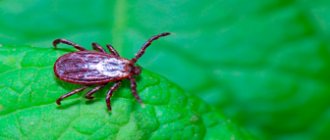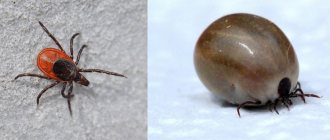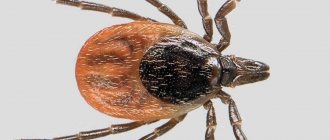In the spring, with the onset of the first warm days, people who often go out into nature or work in gardens and summer cottages are faced with a serious problem - ticks. It also applies to pets who accompany their owners everywhere. Moreover, even to a greater extent.
Our four-legged friends are much closer to the ground than we are; they enjoy playing in fresh grass and even lying in it. But they are practically defenseless against an insidious enemy, while we wear special shoes, trousers and long-sleeved shirts. How to protect your dog from possible danger?
Tick on a dog
Ticks on dogs are often found during the period of parasite activity (spring and summer, sometimes autumn). In warm weather, insects crawl out and wait on blades of grass, tree trunks and foliage of bushes until the intended victim passes by. Ticks determine its location by smell. Having determined the dog’s location, the parasites quickly move to its body and try to find vulnerable areas of the skin - soft and not protected by fur.
You can pick up ticks in the forest, in the park, even while walking along a small alley. These insects are poorly distributed in urban areas, but remain active in villages, holiday villages and large forest parks. Therefore, owners need to be careful not only when traveling out of town with their pets, but also when walking through nature reserves and parks.
The tick usually sits on the belly or is located behind the ears. It bites into the skin and begins to drink blood, plunging its proboscis. Tick salivary glands secrete small amounts of allergens to which some pets are sensitive. But the danger of the parasite lies not in this, but in the fact that it can be a carrier of deadly viruses and dangerous infections.
Therefore, it is so important to provide tick prevention in the summer, as well as constantly check the dog’s body for the presence of attached parasites.
When to examine your dog
While walking or actively playing in the grass, a dog can easily pick up a tick. In order to avoid unpleasant consequences, the animal must be examined. It is best to do this several times during a walk after active games, before going home, and also when you have already entered the apartment and are wiping the dog’s paws. This increases your chances of finding a tick before it bites your pet.
While walking the dog during a period of increased tick activity, I examined Bormann every time he got tired of running and came up to me. Almost every time he brought a bloodsucker on his fur. It is easier for owners of light-colored dogs to detect the pest, but those whose pets have dark hair have to be extremely careful.
What does a tick look like on a dog?
The appearance of the parasite depends on how long the tick has been drinking blood from the dog. The hungry parasite is small in size, flat, with 8 legs. The head is dark, the body can be green, black or gray, as well as brown. Different shades of color are allowed. The size of the ixodid tick, the most dangerous external tick, in its initial form does not exceed a few millimeters. It is smaller than the pad of a finger. But as the abdomen fills with blood, the tick grows in size and can inflate up to 1–2 cm.
Usually, owners notice the parasite after it has attached itself. The insect can be confused with a wart or a voluminous mole, since when inflated it is round, and the head is not visible behind the large body. Redness and slight swelling appear at the site where the parasite attaches to the skin. If the tick has already fallen off, there will be a wound with a small bump. If it ruptures as a result of mechanical damage, the owner may notice a lump with a black dot in the middle. This is the head of an insect stuck in the epidermis.
There are about 48 thousand species of ticks. In addition to external ones, such as ixodidae, there are also intradermal and ear ones. However, they are not as common as ixodids, and are small in size, which is why they are inaccessible to the human eye.
How can you remove an attached tick?
Various devices are used to remove a tick:
- tweezers,
- a thread,
- syringe,
- a special device - a tick-cutter or Tick-Kay.
There are a lot of tips on the Internet for removing ticks using oil, gasoline, turpentine, nail polish and much more, but personal experience shows that these methods do more harm than good. In all cases when I tried to remove the tick by smearing it with some kind of product, it died. It is much more difficult to remove a dead parasite from under the skin than a living one.
What to do if your dog is bitten by a tick
If your dog is bitten by a tick, you should not hesitate to contact a veterinarian. It is not necessary to go to the clinic right away. The action depends on the type of tick that bit the pet.
The most common and dangerous parasite is the ixodid tick. It is its bites that cause encephalitis, piroplasmosis and other dangerous diseases. If the owner finds the tick already attached, he should try to remove it. If successful, the parasite is placed in a flask or container in case it needs to be analyzed. It is recommended to send the parasite for testing in the following situations:
- an ixodid tick bit a pet in an area where many cases of attacks by encephalitis parasites have been reported;
- Deviations were noticed in the dog’s behavior that may signal the development of the disease.
In both cases, it is important not only to deliver the material to a specialist for analysis, but also to have your pet examined at a veterinary clinic. The specialist will give several injections that will reduce the risk of developing fever and viruses.
You need to monitor your dog after a bite not for several hours, but for several weeks, since some viral pathologies have a long incubation period. At the first signs of disease development, you should contact your veterinarian.
To accurately determine whether you need to visit a doctor, it is recommended to call your veterinarian immediately after discovering the parasite. A consultation will help you choose the best method for tick removal.
Which white tick is dangerous to humans?
A tick that is dangerous to humans, which can have a white color, is a macro tick, the most famous and widespread is the ixodid tick.
There are the following types:
- European or forest;
- taiga;
- village, meadow.
The ixodid tick is quite large - after biting and sucking blood it can reach 1 cm. If you find a tick on your body that looks like it has a white bottom - this is not a separate subspecies, this color is typical for most female ticks; when filled with blood, the tick's body stretches and thus its shade becomes less saturated and brightens.
It is also worth remembering that the ixodid tick is a family of ticks that has hundreds of species. So, of course, they can be of different colors and shades, including light ones: beige, grayish, pink, or have a white pattern on the back (meadow tick).
The essence of the problem of a tick bite does not change from their appearance; any ixodid ticks can be carriers of diseases - encephalitis, anaplasmosis, borreliosis, tick-borne typhus, various types of fevers, in general, all those for which it is worth thoroughly studying the possibilities of avoiding tick bites and rules of conduct after a bite.
Perhaps the main problem with a white tick is that it is much harder to notice it on the skin than a dark one, especially if it is a small individual. People often mistake such a tick for a wen or some kind of small wound.
Be careful, especially if you live or visit areas where tick-borne encephalitis is endemic, be sure to inspect your skin after hiking and walking in nature. Take a close look at the photo of the white ixodid tick to identify and neutralize the parasite in time.
Another common type of ectoparasite (external) is ticks in dogs. When people talk about ticks and how dangerous it is in the warm season, they mean one of the types of skin parasites – ixodid ticks (Ixodidae). In fact, several species of these arthropods parasitize dogs. Some of them gnaw the skin of animals, others suck blood, and for others, the lymph and skin secretions of your pet are a source of food. As a result of the activity of ticks, the animal may develop a severe allergic reaction, viral and bacterial diseases, as well as abscesses and dermatitis.
Signs of a bite
The main sign of parasite damage is a lump after a tick bite on a dog. It forms around the wound and can reach up to 1–2 cm in diameter, depending on the pet’s tendency to allergic reactions. The swelling is usually reddish and, when pressed, causes pain in the pet.
The lump does not always occur. Sometimes it simply remains hidden under the fur. There are other signs by which you can understand that the dog is in danger:
- the pet scratches a certain area (behind the ears, groin, abdomen);
- the dog has lost activity and appetite, mostly lies down;
- the dog reacts aggressively to touch, especially in a certain place;
- heat is noticeable when touched;
- the nose became dry and hot;
- The dog is constantly breathing with its tongue hanging out, although it has not been subjected to either increased physical activity or exposure to heat.
If all of the above signs occur, the dog should be examined. If the pet shows aggression (this is a normal defensive reaction for a wounded or sick animal), a muzzle is put on. Holding the dog by the collar, you need to check the main places where the parasite usually attaches itself. This is the area behind the ears, neck, especially the strip under the collar, groin, back of the paws, tail, withers. If the parasite was not found in these places, you will have to examine the dog's entire body, since sometimes the tick can infect other areas.
After a parasite bite, various nonspecific symptoms may develop. Among them:
- increase in body temperature (from 38–39 to 40–42);
- increased pet fatigue;
- refusal of food and water;
- aggression;
- problems with coordination;
- drowsiness;
- swelling of the bite area and the development of inflammation with the release of pus or redness.
These signs indicate the need to take your pet to the veterinarian.
The best treatment method is an antidote for a tick bite for a dog. The antidote is selected depending on the disease that the tick suffered. There are also universal means. Thus, some German companies produce special tablets for oral use that provide protection against encephalitis in dogs for a whole month, even in the event of a bite. However, such remedies should be used before the bite: for example, when the family is going to go to the country or relax in nature.
After a tick infestation, injectable drugs are used for intravenous administration. They provide the fastest possible action and allow you to stop the development of diseases at an early stage.
Preventive actions
To protect your pet from tick infestation, you must adhere to the following rules:
- Do not allow sick animals to come into contact with healthy ones.
- Avoid walking your dog in areas where there are stray animals.
- Try to keep your pet away from other dogs when visiting the veterinarian.
- Use special collars, repellers and other means of protection against ticks.
- As prescribed by your veterinarian, carry out preventive treatment against parasites.
- Disinfect and boil care items for sick animals.
- Never use other people's collars, combs or muzzles.
- Strengthen your dog's immunity with balanced nutrition and vitamin supplementation.
Prevention against ixodid ticks consists of treating the animal with anti-tick compounds before a walk, wearing special collars and ultrasonic repellers, as well as a thorough examination of the animal returning from the street. Visual inspection is the most important component of prevention. It doesn’t matter at all how long a tick can sit on a dog, the important thing is that infection with dangerous diseases occurs within 30-60 minutes of sucking on this little bloodsucker. The sooner you remove the tick, the greater your pet's chance of survival.
What can you do at home?
If your dog is bitten by a tick, be sure to find out the symptoms and treatment methods at home. An uninformed owner may take actions that will harm the pet.
So, you cannot do the following:
- Expand the wound to remove the proboscis or head of the tick.
- Use oil or alcohol to suffocate the parasite. The alcohol composition is suitable for disinfection after the insect has been removed.
- Allow the dog to scratch the wound. It is best to wear a collar. If the pet tries to lick the bite site (when located on the paw), a muzzle is put on.
- Leave the head of the tick in the dog's body. This will lead, at best, to suppuration of the wound, and at worst, to encephalitis.
- Remove the tick by pressing on its body. If you press on the abdomen of the parasite, it will begin to release saliva containing pathogens into the dog’s blood with redoubled force.
If you have access to a veterinary clinic, you should visit it as soon as possible. But even at home, you can take some actions that will reduce the risk of developing pathologies.
It is necessary to remove the parasite using one of the common methods. Fatty substances should not be used for suffocation. You can use thread, tweezers, or a special tool to pull out the tick. It is not advisable to use a needle. If it is not sterile even after heating and treating with alcohol, an infection will enter the blood. A rusty instrument will lead to sepsis.
It is better for dog owners to purchase tick removal tools in advance. They can be purchased at a human pharmacy. Special adaptations for animals are more difficult to find. You can try looking for them in online stores, but there is not much difference between “human” and veterinary forceps for removing the parasite. If you have these forceps in your arsenal, you need to grab the parasite right at the head and carefully pull it out. The device is equipped with a special flask. The insect is placed there so that it can be easily transported to a veterinary clinic for analysis.
It is equally convenient to remove a tick using tweezers. It should be small, manicured, without signs of rust. The tick is grabbed close to the skin and pulled out of the dog's body using twisting movements. Do not sharply pull or grab the parasite by the lower or middle part of the body.
The last method is to remove it with a thread. It is not suitable for eliminating small ticks. The thread is draped over the body of the tick and tightened around the head. Using slow movements, you need to pull the parasite out of the body. The tick must be held perpendicular to the skin.
If the parasite is too small or has burrowed deep into the skin, none of the above methods will work. Then the wound is treated with iodine, and the owner goes to the clinic to have the parasite removed with the help of a veterinarian. The specialist will make a small incision or use miniature tweezers.
Advice: if the tick is small and hard to see, and also if it is buried deep into the skin, you need to remove the dog’s hair (you can carefully shave it without touching the wound) and rub the affected area with damp gauze. The dark (or gray) body of the tick will immediately become noticeable.
How not to pull out an embedded parasite
Before removing an attached bloodsucker, it is worth understanding how not to do this.
Table: how not to remove a tick and why
| Removal method | Why can't you do this? |
| Using oil, glue, gasoline | It will lead to the death of the tick, but the tick itself, contrary to popular belief, will not crawl out. |
| Pulling out a tick by hand | The head of the tick can remain in the pet's skin, and the blood of a torn parasite that gets on the hands can lead to infection. |
| Burning the tick (for example, with a cigarette) | Will lead to the death of the parasite, but will not help remove it. In addition, you can burn your dog. |
Possible consequences of a bite
The consequences of a tick bite on a dog are varied and dangerous. The biggest fear of dog owners is encephalitis. There is debate as to whether it is transmitted to dogs. Some experts give a positive answer. This infection affects the pet’s brain in a matter of hours and can lead to death in 1–2 days.
In addition to encephalitis, there are other infections and viruses. Amid the fear of viral diseases, dog owners forget that another consequence of a bite is no less dangerous - the development of suppuration and inflammation. If you do not remove the head and proboscis of the tick or forget about disinfection measures, the lump may swell and begin to secrete pus.
Inflammation can lead to weakened pet immunity, loss of activity, appetite, and general exhaustion. If it develops to a serious size, necrosis of tissue and some muscles close to the skin is possible.
Sometimes dogs themselves lead to the development of infection. They scratch the bite site and bring dirt into it. In this way, dermatitis, lichen, fungal skin infections and even blood poisoning can begin. If your pet constantly scratches the sore, the skin around which is often itchy, non-healing ulcers on the skin are likely to develop. And against the background of weakened immunity due to the development of infection, pets begin to develop colds, conjunctivitis, and fever.
Ticks can be intermediate carriers of helminth eggs. Once in the dog’s body, these parasites remain in it forever (in the absence of treatment), causing digestive disorders, exhaustion, and damage to the liver and biliary tract.
Diseases transmitted through ticks to dogs are destructive to health, sometimes fatal. Experts note the following most dangerous infections that develop as a result of the release of viruses and bacteria from the salivary glands of the parasite:
- Piroplasmosis. The disease develops against the background of the activity of single-celled bacteria. Microorganisms lead to the breakdown of red blood cells in the blood, which ends in death due to failure of the lungs and heart.
- Borreliosis. Leads to joint destruction, arthritis, and central nervous system dysfunction. The disease is transmitted to humans through blood (for example, through a pet bite). Here is written in detail about the Borreliosis mite.
- Bartonellosis. The disease leads to exhaustion of the body, followed by weight loss, and disruption of the cardiovascular system. Characteristic is the development of anemia, which reduces the pet’s immunity and activity. An inflammatory process in the joint area, accompanied by a feverish state, is possible.
- Encephalitis. Against the background of this disease, fever develops and disturbances in the functioning of the central nervous system appear. In the terminal stage, the pet's brain fails.
How to treat a tick bite on a dog to reduce the likelihood of developing diseases? It is necessary to wash the wound with soapy water and then apply a 5% iodine solution. If you suspect the development of pathology, then you need to go to the veterinarian.
Veterinarian advice
If, when removing a tick, the head remains in the wound, try to pick it up with tweezers and pull it out, twisting it out; if that doesn’t work, just treat it regularly with iodine. A small abscess may form and after some time the body will reject the foreign body. It’s not easy to pull out the head with a needle because of the spines on the proboscis, you can dig into it to the point of significant inflammation.
You can’t cajole a tick! The oil does make it impossible for him to breathe, but before he suffocates and/or falls off, he regurgitates the contents of his intestines into the wound. The likelihood of contracting Lyme disease in this case increases significantly (this is also very important for humans). Vaseline or machine oil, kerosene and other caustic or oily liquids will have approximately the same effect. Well, from the point of view of wasting time, this is an additional risk.
veterinarian Elena Gogua
https://vetersovet.ru/chto-nujno-znat-o-kleschah/
The first thing you must remember is that most diseases are transmitted within 12-48 hours from the moment the tick bites. Prompt tick removal will prevent transmission of most pathogens. Therefore, if you see a tick on an animal, it must be removed immediately. To do this, you need to carefully remove the parasite using rotational movements, unscrewing it like a screw from the dog’s skin, without damaging the integrity of the tick itself. Treat the resulting wound with an antiseptic. The tick can be sent to a veterinary laboratory or brought to the clinic to determine the type and, accordingly, the diseases that can be transmitted. Your veterinarian will be able to refer him to a laboratory to diagnose infections.
Ekaterina Gerasimova, veterinary dermatologist
https://www.woman.ru/home/animal/article/199828/
Ticks pose a huge danger to dogs, as they are carriers of piroplasmosis and other diseases. With the parasite's saliva, the pathogens immediately enter the animal's blood and multiply there. As soon as you notice that after a walk your dog began to look depressed for no reason, his temperature rose sharply, and he constantly squats on his hind legs - this is a sure sign that the disease is progressing. Without timely medical attention within four to five days from the moment of the bite, your dog will simply die! If drops of blood appear in the urine, then, unfortunately, you are too late. Time has passed. Therefore, my advice to you is not to be lazy and always carefully examine your dog after a walk for ticks. Well, also, do not neglect various preventive measures: vaccinations, ointments, special collars, etc. The veterinary clinic will also tell you what is best for your dog.
veterinarian Nikolay Loginov
https://www.aif.ru/dontknows/eternal/chto_delat_esli_vashu_sobaku_ukusil_kleshch
It is better to prevent the disease, the animals must be treated, there is a large number of medications: drops on the withers, collars, spray, powder, tablets, a vaccine has been developed, but it is ineffective. Not only is it toxic, it does not save you from the disease and even hides the clinical picture, so such animals end up with complications. Treatment begins already in March, the disease season begins with warming and lasts until mid-June, the second outbreak begins in August and continues in good weather until October.
veterinarian Irina Valerievna Chikareva
https://penza-press.ru/lenta-novostey/110530/sezon-klecshej-u-sobakovodov-kak-uberech-pitomca-ot-ugrozy-briefing
The longer a tick sits on a dog, the more parasites it manages to release into it. If you have time to remove a small tick that has just attached itself, then the risk of infection is minimal. If a tick on an animal turns out to be the size of a pea, then the parasite latched on several hours ago, and if the tick is the size of a bean, at least 12 hours have passed. It is advisable to take a dog with such a finding to a veterinary clinic, where the pet will be given a prophylactic dose of antidote - this way you can save on treatment and alleviate the dog’s condition.
Head of the veterinary clinic “Four Paws” Natalya Egorkina
https://www.ryazan.kp.ru/daily/26818.4/3854790/
Can a tick fall off a dog on its own?
What does a tick do after it drinks blood? If we are talking about an ixodid parasite, then the insect can actually go away on its own. However, if your dog is affected by scabies mites, you should contact your veterinarian. Otherwise, they will seriously damage the ear canals or skin.
Despite the fact that the parasite falls off on its own over time, you shouldn’t wait for it. The dangerous organism must be removed immediately. The tick can stay on the pet's body for 24 hours. During this time, the risk of infection reaches critical levels. And when an insect gets drunk, it greatly increases in size and can fall under its own weight. In this case, the proboscis will remain in the body. If the insect is a carrier of a virus or infection, then the proboscis remaining in the body will lead to the development of pathology. Even the proboscis of a “pure” ixodid tick can lead to inflammation and suppuration.
A dead tick on a dog does not fall off. Its removal without human intervention can only occur if the tissue begins to regenerate and new connective cells displace the foreign object. However, ticks that have settled too deeply can remain in the body and simply become overgrown. The abdomen and main part of the body will fall off, and the head and proboscis will grow in. After this, it will be very difficult to remove the foreign object: the veterinarian will have to cut the pet’s skin, which will cause him unnecessary discomfort.
Which ticks are white?
More than 50 thousand arachnid insects are known to science, of which a good third are mites, but none of them, under natural conditions, are white in color. Visually, mites may appear white due to the coating or the state they are in at the moment. So, which ticks are white?
Turn white when they drink blood:
Important! All four species listed above are relatives belonging to the species of grassland or ixodid ticks.
Scabies, dust and spider mites have a white coating, but they are microscopic. Flour mites have a white edge but are not parasitic on dogs. Ear mites are almost white in color. However, in fact, these parasites have an almost transparent shell.
What is the mechanism of the disease
The parasite Piroplasma canis is carried by several species of dangerous ixodid ticks: Dermacentor marginatus, Dermacentor pictus, Rhipicephalus turanicus, Rhipicephalus sanguineus. With a tick bite, the animal is directly infected with piroplasms. It is in the saliva of the tick, which it injects into the bite wound to prevent blood clotting, that piroplasms are found.
It is not so much the piroplasms themselves that are dangerous, but the changes in the body that occur under their influence. Parasitizing in the blood (erythrocytes), they have a destructive effect. Red blood cells break down and release a huge amount of hemoglobin, which the dog’s body cannot cope with. This is how the body becomes intoxicated with decay products. As a result, the liver, kidneys, spleen, brain, and other vital organs suffer. Ixodid ticks become active with the onset of warm weather, when the first greenery appears. The peak of tick attacks is from April to November.
Symptoms of piroplasmosis
Typically, from the moment of contact with a tick to the initial manifestations, three to twenty days pass. The disease is characterized by a fairly acute onset, that is, there is a sharp increase in the dog’s body temperature – up to 41 (and even 42) degrees. Fever is accompanied by:
- weakness;
- apathy;
- loss of orientation in space;
- nausea with vomiting;
- severe pain in the abdominal area.
At the initial stage of the disease, body temperature usually “jumps.” However, after weeks or 10 days, the fever constantly remains at the same level - within 41-42 degrees. In the absence of adequate treatment, the disease progresses to the terminal stage. In this case, the body temperature drops to normal, and sometimes lower.
Piroplasmosis in dogs is also characterized by: pallor of the mucous membranes with jaundice, soreness and enlargement in the liver area. Weeks after the onset of the disease, blood appears in the urine (hemoglobinuria), as well as decreased (or completely absent) urination. At the terminal stage of the disease, symptoms of liver and kidney failure are diagnosed. As a result, blood poisoning occurs, that is, sepsis develops, as well as nonspecific pneumonia. The dog can die from such complications.
The incubation period for piroplasmas is about 7-10 days from the moment of the tick bite. After this, the dog exhibits symptoms of the disease, namely:
- a sharp decrease in appetite or complete refusal to eat;
- general lethargy and causeless fatigue;
- difficult gait, the hind limbs are especially weak;
- increase in animal body temperature;
- pallor or yellowing of the mucous membranes (visible in the oral cavity) and the whites of the eyes;
- change in urine color to dark or bloody (hematuria).
In the acute form of piroplasmosis, which lasts about 2-4 days, the symptoms are more pronounced:
- urine turns reddish or brown (caused by increased bilirubin);
- increased temperature (up to 42 degrees) and fever;
- the pulse quickens and the mucous membranes turn yellow;
- the dog becomes apathetic and cannot walk on its hind legs.
If the dog has increased resistance, then a chronic course of piroplasmosis is possible (5-6 weeks). The clinical picture with this course is blurred, so sometimes the disease is diagnosed even in winter. But there are some obvious signs of the disease:
- the elevated temperature lasts only a couple of days;
- a sharp deterioration in appetite, severe exhaustion;
- improvement in the dog’s condition turns into apathy and vice versa;
- indigestion alternates with constipation.
A hyperacute is also known , the symptoms of which are practically indistinguishable. This course of the disease is fatal, so it is extremely important to immediately contact a veterinarian.











